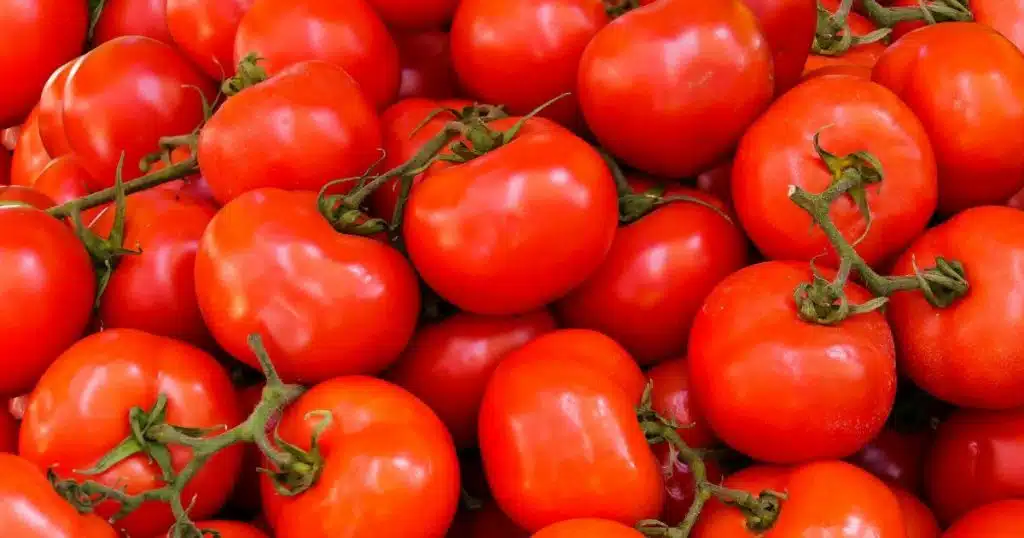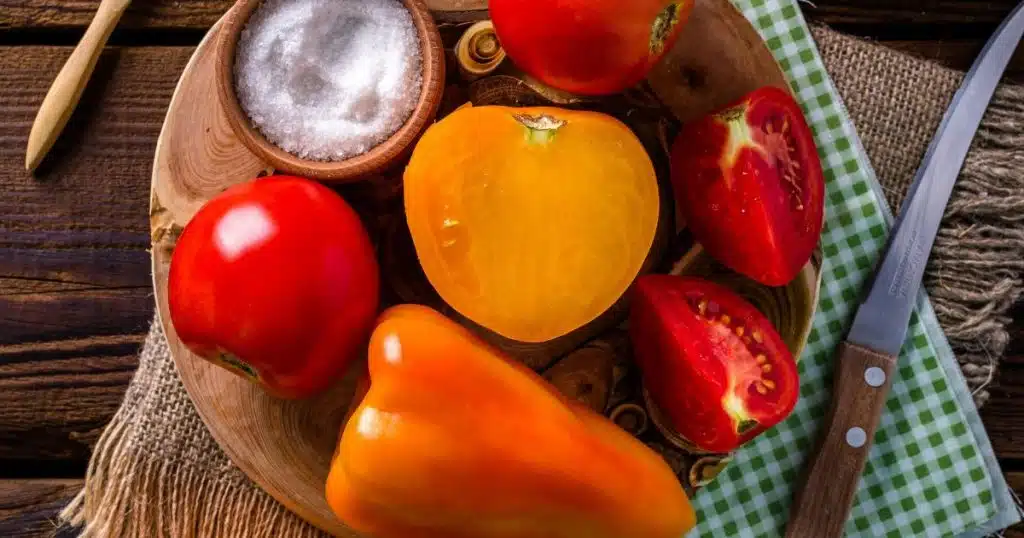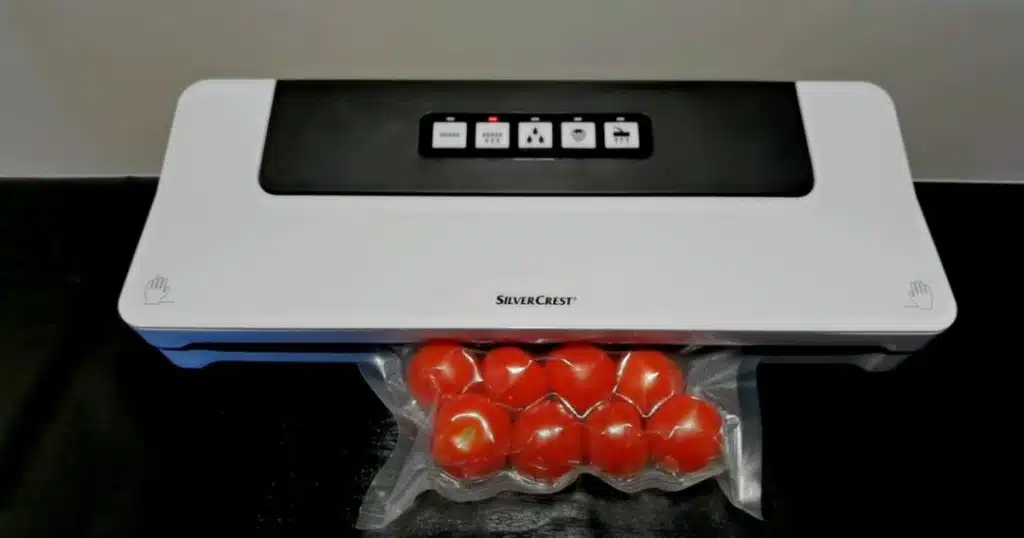As an Amazon Associate I earn from qualifying purchases.
Tomatoes are a kitchen essential worldwide, perfect for making sauces, soups, or salads.One of the challenges faced by tomato lovers is finding the best way to store them for longer periods without losing their flavor and nutritional value. Vacuum sealing is one method that is growing in popularity as a food preservation technique. But can you vacuum seal tomatoes? The answer is yes, and in this article, we’ll explore everything you need to know about vacuum sealing tomatoes, from the benefits to the step-by-step process, along with tips for keeping your tomatoes fresh for months.

Why Should You Vacuum Seal Tomatoes?
Vacuum sealing is a process where the air is removed from a bag or container to create an airtight seal. When it comes to food preservation, oxygen is one of the primary culprits behind spoilage and bacterial growth. By eliminating oxygen, vacuum sealing helps to extend the shelf life of your food.
Tomatoes, like other fruits and vegetables, are highly perishable due to their water content. Without proper preservation, they can quickly spoil, losing their freshness, flavor, and nutritional value. Vacuum sealing provides several benefits:
Extended Shelf Life: By removing air from the packaging, vacuum sealing can extend the shelf life of tomatoes from a few days to several months, especially when combined with freezing.
Preserving Nutrients and Flavor: Vacuum sealing helps retain the tomatoes’ vitamins, minerals, and rich flavors by reducing oxidation.
Preventing Freezer Burn: If you plan to freeze your tomatoes, vacuum sealing protects them from freezer burn, a common issue when freezing produce in standard bags.
Reducing Food Waste: Instead of letting your tomatoes spoil or throwing them away, vacuum sealing lets you preserve and store them for later use.
How to Prepare Tomatoes for Vacuum Sealing
While vacuum sealing is an excellent method of preserving tomatoes, the process begins long before you bring out your vacuum sealer. Proper preparation ensures that your tomatoes will maintain their texture and taste once sealed and stored. Here’s how you should prepare them:

Select Ripe Tomatoes
Choose tomatoes that are firm, ripe, and free from bruises or damage. Overripe tomatoes may not withstand the sealing process and can become mushy after vacuum sealing.
Wash and Dry Thoroughly
To remove any dirt or pesticides, rinse your tomatoes under cool running water. Make sure to dry them thoroughly with a towel, as excess moisture can lead to ice crystals forming when the tomatoes are frozen.
Consider Blanching
For long-term storage, especially if freezing is involved, consider blanching the tomatoes. Blanching involves briefly boiling tomatoes to loosen their skin, then quickly plunging them into ice water.This method helps maintain their texture and keeps them from becoming mushy.
Remove the Skin and Core
After blanching, peel the tomatoes and remove the core. If you prefer, you can also remove the seeds, but that’s optional depending on your recipe preferences.
Pre-Freeze Tomatoes
Before vacuum sealing, it’s a good idea to pre-freeze the tomatoes. Place them on a tray in the freezer for a few hours. This step ensures that the tomatoes maintain their shape and do not get crushed during the vacuum sealing process.
Step-by-Step Guide to Vacuum Sealing Tomatoes
Now that your tomatoes are prepped, it’s time to vacuum seal them. Here’s a straightforward guide to help you get it right:
Choose the Right Vacuum Sealer
Investing in a quality vacuum sealer is key to successful food preservation. Some vacuum sealers come with settings specifically designed for delicate items like fruits and vegetables, which is perfect for tomatoes.
Use High-Quality Vacuum Sealing Bags
Make sure to use BPA-free vacuum sealing bags that are suitable for both freezing and cooking. These bags are thicker and more durable than standard plastic bags, reducing the risk of punctures or leaks.
Portion Your Tomatoes
Before sealing, decide whether you want to seal whole tomatoes, diced tomatoes, or tomato puree. It’s often more convenient to vacuum seal tomatoes in portion sizes, especially if you plan to use them in recipes later.
Place Tomatoes in the Bag
Carefully place the tomatoes into the vacuum sealing bag, ensuring that they are spread evenly. Avoid overstuffing the bag to prevent damage during the sealing process.

Seal the Bag
Position the open edge of the bag in the vacuum sealer. Most modern vacuum sealers have an automatic function that removes the air and seals the bag in one step. For delicate items like tomatoes, use the “gentle” or “moist” setting if your vacuum sealer offers it.
Label and Date
After sealing your tomatoes, label the bags with the date. This step is important for keeping track of how long your tomatoes have been stored and ensuring you use them within the recommended time frame.
Storing Vacuum-Sealed Tomatoes
Once you’ve successfully vacuum-sealed your tomatoes, it’s time to store them. Depending on how long you want to keep them, there are two primary storage methods:
Refrigeration
If you plan to use your vacuum-sealed tomatoes within a week, you can store them in the refrigerator. Vacuum sealing will extend their freshness, but tomatoes are best used sooner rather than later if refrigerated.
Freezing
For long-term storage, freezing is the way to go. Vacuum-sealed tomatoes can last in the freezer for 6 to 12 months. The vacuum sealing process prevents freezer burn, allowing the tomatoes to retain their flavor and texture. When you’re ready to use them, simply thaw the tomatoes in the fridge overnight or run the sealed bag under cool water for a quicker thaw.
Using Vacuum-Sealed Tomatoes in Recipes
Once you have a stash of vacuum-sealed tomatoes, you can enjoy the convenience of having fresh-tasting tomatoes year-round. Here are a few ways to use your preserved tomatoes:
Soups and Stews
Vacuum-sealed tomatoes are perfect for soups, stews, and chili. Simply thaw the tomatoes and add them to your pot for a burst of rich flavor.
Sauces
Tomatoes are a base for many sauces, such as marinara, salsa, or pizza sauce. Vacuum-sealed diced or pureed tomatoes can be used directly from the freezer for a quick sauce preparation.
Casseroles and Bakes
Add your vacuum-sealed tomatoes to casseroles or bakes for added moisture and flavor. Just thaw them and incorporate them into your dish as you would fresh tomatoes.
Salsas and Dips
You can thaw vacuum-sealed tomatoes and use them in fresh salsas and dips. Be sure to drain any excess water if the tomatoes seem overly watery after thawing.
Tips and Tricks for Vacuum Sealing Tomatoes
To make the most out of your vacuum-sealing experience, here are some additional tips to consider:
- Avoid sealing wet tomatoes: Moisture can interfere with the sealing process, leading to incomplete seals. Be sure to dry tomatoes thoroughly before sealing.
- Use a vacuum sealer with a pulse function: Some vacuum sealers offer a pulse function, allowing you to control the suction manually. This feature is ideal for delicate items like tomatoes, preventing them from being crushed.
- Seal tomato-based sauces: If you have excess tomato sauce, you can also vacuum seal it. Freeze the sauce in a container first, then transfer the frozen block to a vacuum-sealing bag for long-term storage.
Common Questions About Vacuum Sealing Tomatoes
Yes, you can vacuum seal raw tomatoes. However, it’s recommended to blanch them first to preserve their texture and flavor, especially if you plan to freeze them.
Tomatoes can last between 6 to 12 months when vacuum sealed and kept in the freezer.
Absolutely! Tomato puree is a great candidate for vacuum sealing. Simply portion out the puree into smaller bags, freeze it flat, and vacuum seal the frozen blocks for easy storage.
While vacuum-sealed tomatoes retain much of their flavor, their texture may become softer after freezing, making them better suited for cooking rather than fresh salads.
Final Thoughts
Vacuum sealing is a highly effective method for preserving tomatoes, offering benefits like extended shelf life, retained nutrients, and reduced food waste. Whether you choose to vacuum seal whole tomatoes, diced tomatoes, or purees, this method allows you to enjoy the taste of fresh tomatoes year-round, long after the growing season has ended. By following proper preparation and storage techniques, you can ensure that your vacuum-sealed tomatoes stay fresh and flavorful for months to come.
For anyone serious about food preservation, vacuum sealing tomatoes is a game-changer. Whether you’re a home gardener looking to store an abundant harvest or simply want to reduce food waste, vacuum sealing provides an easy and effective solution to keep your tomatoes fresh longer.
Amazon and the Amazon logo are trademarks of Amazon.com, Inc, or its affiliates.
Leave a Reply